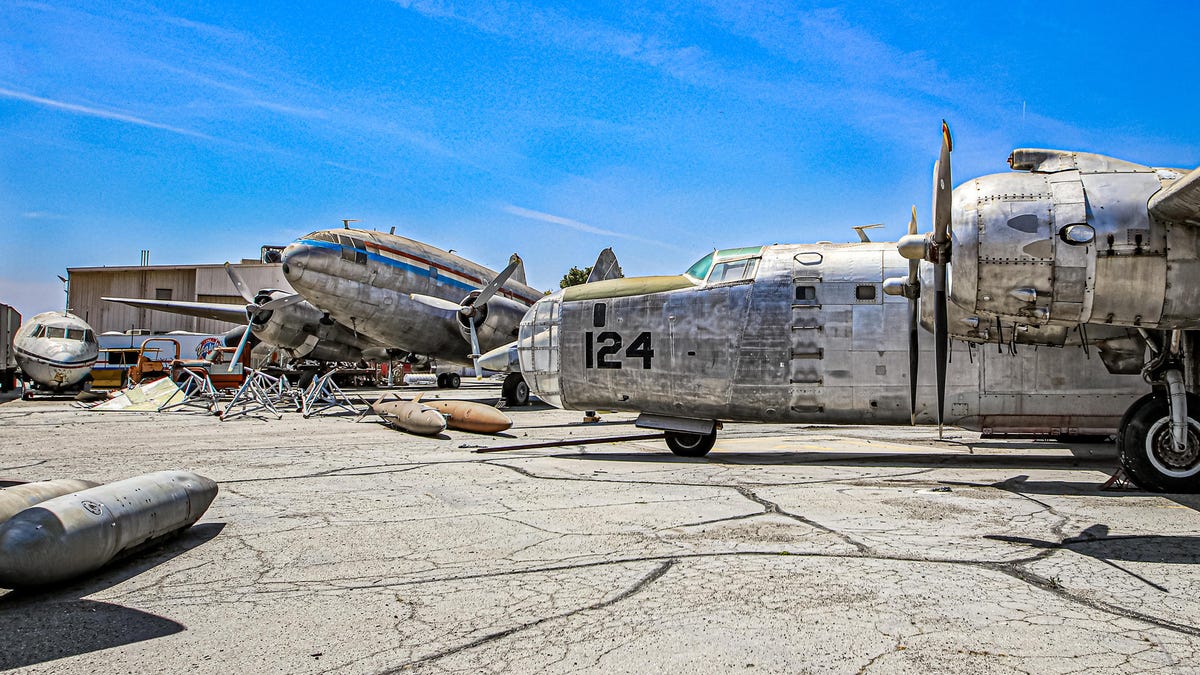 Why You Can Trust CNET
Why You Can Trust CNET Take these broken wings: Touring the Yanks Air Museum Boneyard
Supersonic fighters and WWII bombers sit in silence, awaiting their fate. Some could learn to fly again.

It's quiet. Spooky quiet. I'm surrounded by rust. The decay of aircraft left for decades under an unforgiving sun.
There's a special name for places like this: Boneyard.
It's somewhere between graveyard and junkyard. Aircraft may end up being forgotten here. Once proud machines that carried pilots and passengers through the sky are at rest now, in pieces amid the rusting detritus of unidentifiable parts.
With a bit of luck, and money, the adjacent Yanks Air Museum in Chino, California, will resurrect these steel and aluminum carcasses. Their experts could restore these fabulous flying machines to their former glory. At worst, they'll become photographed museum pieces. But in some cases they might fly again. Roar once again into the sky.
Now, though, they are silent. Let's explore.
Bones of steel
It's rare to get unfettered access to an aircraft boneyard. Most are either off-limits or only accessible via a guided tour. It's strange enough that as I enter the outskirts of the boneyard, I'm expecting someone from the museum to come out and stop me. They don't. Soon I'm surrounded by rusting steel and peeling paint.
Stacks of cargo containers hide additional wonders, but they're out of reach. In fact, there's a pretty clear path through the boneyard. No fences, just items and aircraft positioned to gently usher you along. Though not a huge space, it's easy to position yourself so that the outside world disappears and you're isolated among the aircraft remains.
Many of the aircraft are still quite recognizable. A Navy F-4, for instance, sits across from an F-5, an F-104 and an F-105. A wingless, cockpit-less A-7 Corsair II is a bit harder to identify. I'm most puzzled by what looks like a flat, wide truck, yet the sides show clearly where wing shapes once were. It's not until I notice vertical ducts that I figure out what it is: hovercraft. All the pieces are piled nearby and there's no skirt. This one won't be floating away anytime soon.
Hunting for more aviation treasure, I continue along my own path where it seems safe. I'm have no idea when my last tetanus booster was, which probably means it was too long ago to be effective.
I step around some more cargo containers and get a surprise: much bigger airplanes. I clock one as a Curtiss C-46, but the other I had to look up: a Convair C-131. They're in decent shape, considering. A polish and some clear coat and you could probably put them in a museum, if you had a hangar big enough.
Beyond is one of the rarest aircraft I've seen today. Not the B-24 it seemed at a distance, but a PB4Y-2 Privateer patrol bomber. Nearby is a Grumman Albatross seaplane that looks almost ready to fly, and another F-105 that definitely isn't. Rows of jet engines, flaps, ailerons, and other assorted pieces are like duralumin filler among the derelict aircraft. I catch a glimpse of the nose of a B-52 as I leave.
Preservation
Boneyards can serve different purposes. The massive, and perhaps best known, boneyard at AMARG functions largely as a holding lot for aircraft that might be needed in the near future. It also functions as a repository for parts. Many of the aircraft still flown by the military are decades old. Parts are scarce.
The boneyard at the Yanks Air Museum is not just for show. The museum employs an aircraft restoration team. They were in the process of bringing several aircraft back to life during my visit. With their boneyard they'll be able to expand their collection, or sell and trade restored aircraft with museums all over the world.
So there's a bit of hope in my mind as I finish my exploration of this strange, yet desolately charming place. Maybe in a few years some of these planes will be brought back from the brink, one more survivor of their type restored for future generations to study and admire.
But for now they sit in the harsh sun and gravel, silent. Waiting.
As well as covering audio and display tech, Geoff does photo tours of cool museums and locations around the world, including nuclear submarines, aircraft carriers, medieval castles, epic 10,000-mile road trips and more.
Also check out Budget Travel for Dummies, his travel book, and his bestselling sci-fi novel about city-size submarines. You can follow him on Instagram and YouTube.

